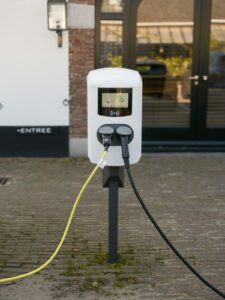
Home / EV Charging News / Car Chargers vs. Wall Chargers
Today we are surrounded by a wide range of devices that require charging. Smartphones, tablets, laptops, and even electric cars are all part of our daily lives, and the need for charging these devices is constant. With the increasing dependence on technology, it has become essential to have a reliable charger that can meet our needs. In this article, we will compare two popular types of chargers: car chargers and wall chargers. We will discuss the differences between them and help you understand which one is best for your needs.
There are a few additional factors to consider when choosing between a car charger and a wall charger:
When choosing between a car charger and a wall charger, there is no clear winner. Both types of chargers have their advantages and disadvantages, and the best option for you depends on your specific needs and usage patterns. Consider factors such as power output, portability, compatibility, safety, cost, charging cable, number of ports, brand and quality, and usage when making your decision. By choosing the right charger, you can ensure that your devices are always charged and ready to use, no matter where you are.
In conclusion, both car chargers and wall chargers have their advantages and disadvantages. If you need to charge your device quickly and have access to a power outlet, a wall charger is the best option. However, if you are on the move and need to charge your device, a car charger is the most convenient option. It is important to choose a charger that is compatible with your device, safe to use, and fits your budget. By considering these factors, you can choose the best charger for your needs and ensure that your devices are always charged and ready to use.
Can I use any charger to charge my device?
It is important to use a charger that is compatible with your device. Using a charger that is not designed for your device could damage the device or the charger, and may even be a safety hazard.
Are car chargers less safe than wall chargers?
Both car chargers and wall chargers can be safe to use, as long as they are made of high-quality materials and meet safety standards. However, it is important to use a car charger that is designed specifically for use in a car and that has built-in safety features to prevent overcharging and overheating.
Can I charge my device faster with a car charger or a wall charger?
It depends on the specific charger and device. Some car chargers and wall chargers support fast charging, which can charge your device more quickly than a standard charger. However, fast charging can also generate more heat, which can be a safety hazard. Make sure to check the specifications of your device and the charger to determine the best charging speed for your needs.
Can I use a car charger to charge my device while using it?
Yes, you can use a car charger to charge your device while using it. However, using the device while charging it can generate more heat, which can be a safety hazard. Make sure to monitor the temperature of your device and charger and take breaks if necessary.
What should I do if my device gets hot while charging?
If your device gets hot while charging, it may be a sign of a problem with the charger or the device itself. Stop using the charger immediately and unplug it from the power source. Allow the device and charger to cool down before using them again. If the problem persists, contact the manufacturer or a professional for assistance.
Can I charge my device with a USB cable connected to my computer?
Yes, you can charge your device with a USB cable connected to your computer. However, charging your device with a computer may be slower than using a wall charger or a car charger, and may not support fast charging.
Can I charge multiple devices at the same time with a car charger or a wall charger?
Some car chargers and wall chargers come with multiple ports, which can be useful for charging multiple devices at the same time. However, it is important to make sure that the charger can provide enough power to all of the devices at once and that they are compatible with the charger.
$2,890.00 Original price was: $2,890.00.$2,790.00Current price is: $2,790.00.
$3,950.00 Original price was: $3,950.00.$3,450.00Current price is: $3,450.00.
$1,650.00 Original price was: $1,650.00.$1,590.00Current price is: $1,590.00.
$2,290.00 Original price was: $2,290.00.$2,150.00Current price is: $2,150.00.
$1,290.00 Original price was: $1,290.00.$799.00Current price is: $799.00.

Your Power Management Partner for Over 25 Years Future Generations Depend on Our Decisions Today ™
2024 © All rights reserved by CyberSwitching